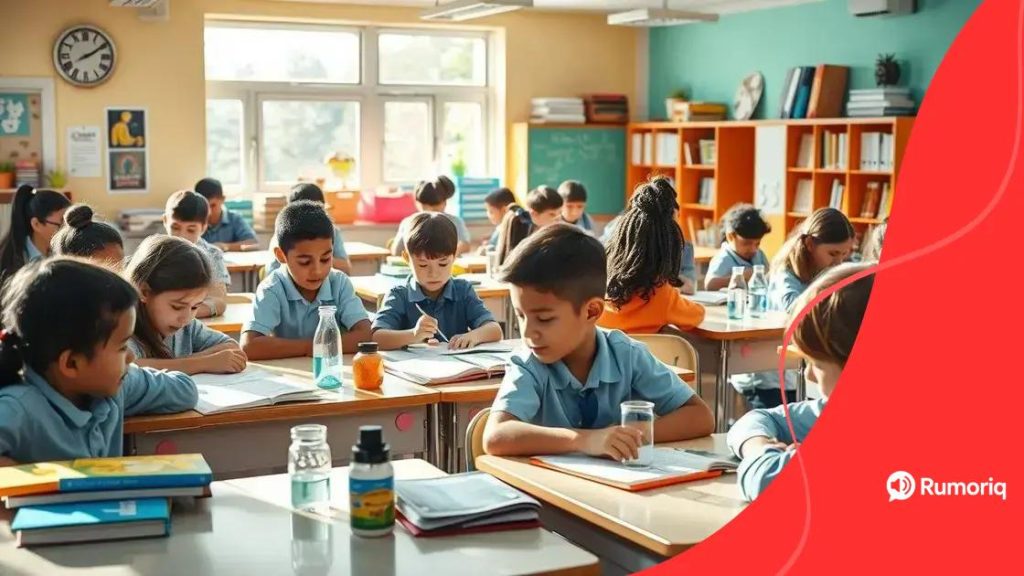Government policies impacting primary and secondary education in 2025

Anúncios
Government policies impacting primary and secondary education in 2025 will focus on technology integration, social-emotional learning, and dynamic assessment methods to enhance student engagement and learning outcomes.
Government policies impacting primary and secondary education in 2025 are set to redefine how our education systems function. Have you thought about what those changes mean for students and teachers alike? Let’s dive into the evolving landscape.
Anúncios
Overview of current education policies
Understanding the current education policies is essential to grasp how they shape our schools today. These policies influence everything from curriculum standards to funding. Let’s break down some key components.
Key Components of Education Policies
From local to federal levels, various policies impact how education is delivered. An effective policy focuses on quality education for all students. It’s crucial for stakeholders to be aware of these aspects. Policies often emphasize:
- Equitable funding for schools.
- Standardized testing and assessment.
- Inclusion and diversity initiatives.
- Teacher qualifications and professional development.
Each of these components plays a vital role in creating a supportive learning environment. Schools must adapt these policies as societal needs change. For instance, adapting curricula to include more technology can better prepare students for the future.
Anúncios
Impact of Recent Education Reforms
In recent years, we’ve seen significant reforms aimed at enhancing student learning and performance. These reforms often focus on improving educational outcomes. They aim to increase accountability for teachers and schools alike.
Another critical aspect of current policies is their focus on mental health support for students. Recognizing that student well-being directly impacts learning, schools are integrating mental health programs into their frameworks. This shift highlights the importance of creating a safe and supportive environment.
Furthermore, many policies are now promoting project-based learning and critical thinking skills. These approaches boost engagement and help students apply what they learn in real-world situations.
Conclusion
In summary, the overview of current education policies reflects a dynamic landscape aimed at improving education for all. By understanding these policies, we can better appreciate the challenges and opportunities within our educational systems.
Key changes expected for 2025
As we look ahead, several key changes are expected in education policies for 2025. These changes aim to enhance the learning experience for all students. Understanding these changes helps us stay informed about the future of education.
Increased Focus on Technology
One significant shift involves the integration of technology in classrooms. By 2025, schools are likely to adopt more digital tools to support learning. This includes:
- Interactive learning platforms.
- Online assessments and feedback systems.
- Virtual classrooms and collaboration tools.
- Artificial intelligence in personalized learning.
Implementing these technologies can help students engage more actively with their studies. Moreover, technology can provide teachers with better resources for teaching.
Emphasis on Social-Emotional Learning
Another important change is the growing emphasis on social-emotional learning (SEL). Schools will prioritize teaching students skills like empathy and resilience. These skills are essential for personal development and success in life. Incorporating SEL means:
- Training teachers to integrate SEL into their lessons.
- Implementing programs that support mental health.
- Creating safe and inclusive school environments.
- Fostering student connections and relationships.
Focusing on SEL helps create a balanced approach to education. It recognizes the importance of mental well-being in students’ overall growth.
Changes in Standardized Testing
Furthermore, the landscape of standardized testing is set to evolve. Many educators are advocating for less reliance on traditional tests. Instead, schools may look to assess student learning through more varied methods. This could include:
- Performance-based assessments.
- Project-based learning evaluations.
- Formative assessments throughout the year.
- Peer and self-assessment practices.
These changes could lead to a more accurate reflection of student knowledge and skills, moving beyond just test scores.
Overall, the expected key changes for 2025 will significantly affect how education is delivered. These adjustments will foster an environment that better prepares students for the future.
Impact on teachers and educators

The impact on teachers and educators from new policies in education is significant. These changes can influence their roles, responsibilities, and how they teach. As we move towards 2025, it is essential to understand these effects.
Shifts in Teaching Responsibilities
With the introduction of new education policies, teachers will face shifts in their daily responsibilities. For example, they may need to:
- Adopt new technologies for instruction.
- Focus more on personalized learning strategies.
- Integrate social-emotional learning into their lessons.
- Participate in ongoing professional development.
These shifts can be both challenging and rewarding for educators as they expand their skill sets.
Support Systems for Educators
As teachers experience these changes, the support systems around them will become increasingly important. Schools may implement additional resources to help educators cope with their evolving roles. This might include:
- Mentorship programs to guide new teachers.
- Access to training for new technologies.
- Collaborative planning time with other educators.
- Counseling services to support mental health.
Providing this support can help teachers feel more confident and effective in their roles.
Professional Development Opportunities
The emphasis on professional development will continue to grow. Educators will likely have access to various training programs focused on the latest teaching methods and technologies. This can take many forms, such as:
- Workshops on integrating technology.
- Courses on differentiation strategies in the classroom.
- Seminars on best practices for social-emotional learning.
- Conferences to share ideas and resources.
Engaging in these professional development opportunities will be crucial for teachers to stay informed and effective.
Overall, the impact on teachers and educators is profound as they adapt to new policies. By preparing them with the right tools and support, we can ensure they continue to provide quality education.
Influence on student learning outcomes
The influence on student learning outcomes is a critical consideration as education policies evolve. Changes in the classroom environment, teaching methods, and support systems can greatly impact how students learn and succeed.
Adapting Teaching Strategies
As new educational policies emerge, teachers will likely need to adapt their teaching strategies. This adaptation ensures that students receive the best opportunities for learning. Strategies that support this include:
- Implementing differentiated instruction to meet diverse learning needs.
- Using technology to enhance engagement and interactivity.
- Incorporating more project-based and hands-on learning experiences.
- Emphasizing critical thinking and problem-solving skills.
These changes can enhance how students grasp complex concepts and retain information.
The Role of Assessment
Assessments will also evolve as part of these new policies. Traditional testing methods may give way to more dynamic approaches that evaluate student understanding effectively. Possible new assessment methods include:
- Real-time feedback through digital platforms.
- Performance assessments that measure skills in action.
- Portfolios showcasing a range of student work over time.
- Peer reviews that encourage collaboration and reflection.
These assessment methods can provide a more accurate picture of a student’s abilities and learning progress.
Impact on Student Engagement
Furthermore, changes in educational policies can significantly influence student engagement in the classroom. When students feel engaged, they are more likely to participate actively in their education. Strategies that increase engagement include:
- Creating a positive, inclusive classroom environment.
- Connecting learning to real-world applications and interests.
- Encouraging student voice and choice in learning activities.
- Using collaborative group work to foster community.
Engaged students tend to achieve better academic results and develop a love for learning.
In summary, the influence on student learning outcomes is a complex interplay of teaching strategies, assessment methods, and student engagement. Understanding these factors is essential for creating effective education policies that support all learners.
The role of technology in education policies
The role of technology in education policies is becoming increasingly important. As schools adapt to the demands of modern society, technology plays a crucial role in shaping educational experiences.
Integration of Digital Tools
One of the most significant changes is the integration of digital tools in the classroom. This includes various technologies that support teaching and learning. Key tools are:
- Interactive whiteboards that facilitate collaborative learning.
- Learning management systems for distributing materials and assignments.
- Educational apps that engage students in interactive lessons.
- Online resources that provide additional learning materials.
By using these tools, teachers can create more engaging lessons that cater to different learning styles and preferences.
Enhancing Accessibility
Technology also enhances accessibility to education for all students. It ensures that learners with disabilities have the resources and support they need. Features that improve accessibility include:
- Speech recognition software that helps students with writing tasks.
- Text-to-speech applications for those with reading challenges.
- Online platforms offering materials in various languages and formats.
- Adaptive technologies that adjust to individual learning needs.
Providing these resources demonstrates a commitment to inclusivity and equal opportunities within education.
Data-Driven Decision Making
Furthermore, technology allows for data-driven decision-making in schools. Educators can use data analytics to track student progress and identify areas for improvement. Analytics can help in:
- Monitoring individual student performance over time.
- Identifying trends in learning outcomes across different demographics.
- Adjusting instructional methods based on data insights.
- Creating targeted interventions to support struggling students.
As a result, schools can make informed decisions that enhance the overall learning experience.
In conclusion, the role of technology in education policies is pivotal in improving educational opportunities. With continued advancements, schools can better serve their students and prepare them for the future.
In summary, understanding how government policies affect primary and secondary education in 2025 is crucial for all stakeholders. As technology becomes more integrated into the learning environment, the responsibilities of teachers will shift, and student engagement will increase. New assessment methods will provide a more comprehensive view of student learning outcomes. It’s clear that with these changes, the future of education holds great potential. By adapting to these evolving policies, schools can create better opportunities for every student and prepare them for success in the modern world.
FAQ – Questions about Government Policies Impacting Education
What are the key changes expected in education policies by 2025?
Key changes include increased technology integration, a focus on social-emotional learning, and updates to standardized testing methods.
How will technology impact teachers in the classroom?
Technology will shift teachers’ responsibilities towards using digital tools and enhancing student engagement through innovative teaching strategies.
What is the importance of social-emotional learning in education policies?
Social-emotional learning helps students develop essential life skills, improving their mental health and academic performance.
How can students benefit from these policy changes?
Students can benefit through personalized learning experiences, improved assessment methods, and greater access to educational resources.